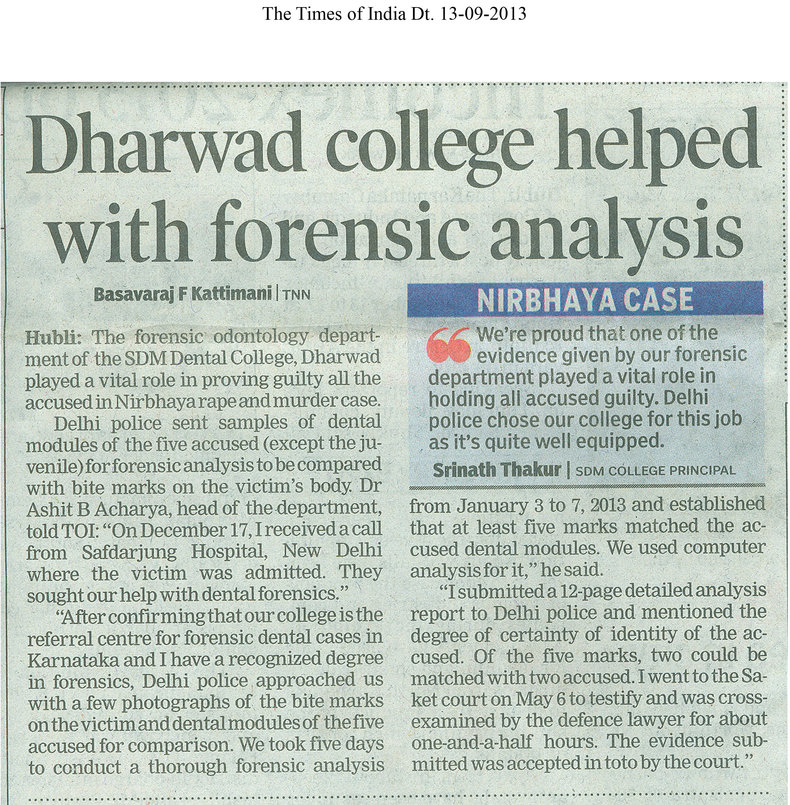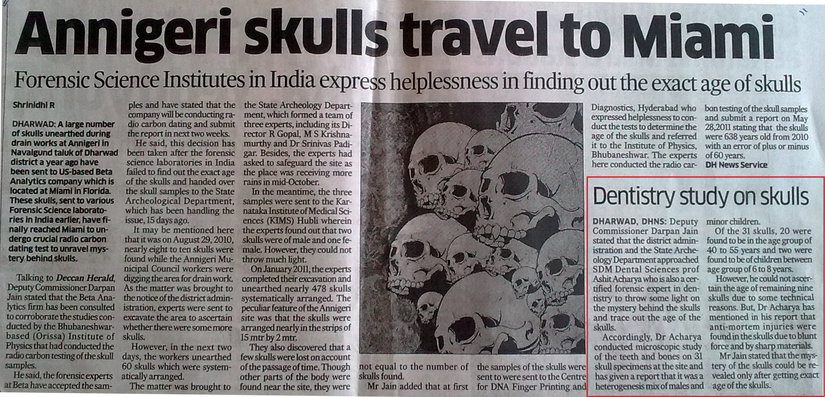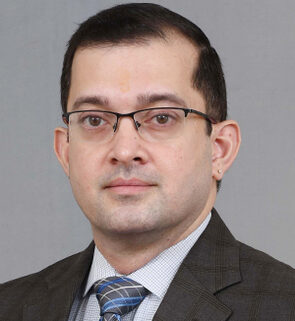Select Cases Referred to Me & My Department
I have had the opportunity to serve in several interesting and high-profile cases, just a couple of which are listed here.
The 'Nirbhaya' Case (New Delhi)
On 1 January 2013, the Delhi Police requested assistance from the forensic odontology department in Dharwad in investigating bite marks which were found on the victim in the ‘Nirbhaya’ case. The very next day, a sub-inspector from the Vasant Vihar Police Station in New Delhi flew down to SDM College of Dental Sciences & Hospital, Dharwad, and handed photographs of the bite marks found on the victim, as well as dental models of five accused adult men in the case. Bite marks are usually found in crimes related to sexual assault. Such bite marks can look very similar to the teeth that caused them, akin to fingerprints.
It was noted that there were 5-6 bite marks on the victim’s body and the same were analysed thoroughly and compared to the teeth of the five accused persons. A computer-based 2D digital analysis was used in this investigation. Following five days of analysis and investigation, a detailed report was handed to the police which concluded that two of the suspects’ dentition could be linked to few of the bite marks.
On 6 May 2013, I was summoned to the Saket Court in New Delhi as an expert witness and cross-examined by the defence lawyers. It appears that the Honourable Judge accepted this testimony and report, which contributed to the conviction of two of the accused persons. My analysis and report was later also upheld by the Supreme Court of India in its judgment dated 5 May 2017.

The Skulls of Annigeri (Karnataka)
On 29 August 2010, many skulls were found when a drainage in the village of Annigeri near Hubli-Dharwad in North-western Karnataka was being desilted. Further excavation over the following days around the area revealed 400 to 600 such skulls. Few clues were available about where the skulls came from and numerous theories were proposed — some believed that they belonged to soldiers killed in wars of yore, while others thought they were the remains of a genocide; still others hypothesised that they may be the remains of human sacrificial rituals prevalent in that region in historical times, while a supposition that they could be the result of a natural disaster was also not ruled out.
In May 2011 the Office of the Deputy Commissioner, Dharwad, and the Directorate of Archaeology and Museum of Karnataka made a formal request to the Department of Forensic Odontology at SDM College of Dental Science & Hospital in Dharwad for assistance in estimating the age, assessing sex, and determining if there were signs of trauma on the skeletal samples. Owing to protected status accorded to the samples, it was necessary to visit the site some 60 km away for examination.
In June 2011, Dr. Sudeendra Prabhu of Oral Pathology and I visited the site for an examination of the remains. The samples were examined carefully onsite over a 7-hour period. Trauma analysis was performed offsite with the assistance of Dr. Abhijit Joshi, an Oral Surgeon from SDM College of Dental Sciences & Hospital. A detailed report on the findings was compiled and the 18-page report concluded that the sample comprised of a heterogeneous population of children and adults, and of males and females, with signs of blunt and sharp force injury.
Carbon dating analysis done in a laboratory in the United States of America revealed that the remains were likely to be 180 years old. The conclusion by the dentists that the remains comprised a heterogeneous mix of males and females, and children and adults helped dispel certain theories and contributed to the authorities’ conclusion that the skeletal specimens were most likely of victims of a famine from 1792 to 1796, as was also recorded by the gazetteer of the Bombay Presidency. In fact, the Archaeology Department acknowledged that the conclusion was arrived at based on the carbon dating analysis and the report submitted by the Department of Forensic Odontology in Dharwad — just one of the many examples and applications of teeth in solving ages-old and present-day mysteries.

The Ajnala Assemblage (Punjab)
In 2016, I was approached by Panjab University, Chandigarh, for assistance in analysing the age-at-death, sex and population affinity -- among other things -- of skeletal material recovered in a disused well at Ajnala, Punjab. These remains were deemed to have historical significance considering that they were likely to belong to Indian soldiers killed by British forces in the 1857 uprising. Following a detailed analysis, a report on the above was submitted and part of the findings are published in the Journal of Forensic Odonto-Stomatology in 2021.

HIghlights
- The 'Nirbhaya' Case Bite Marks Analysis
- Assessment of Age and Sex in the Skulls of Annigeri
- Analyses of Part of the Ajnala Skeletal Assemblage